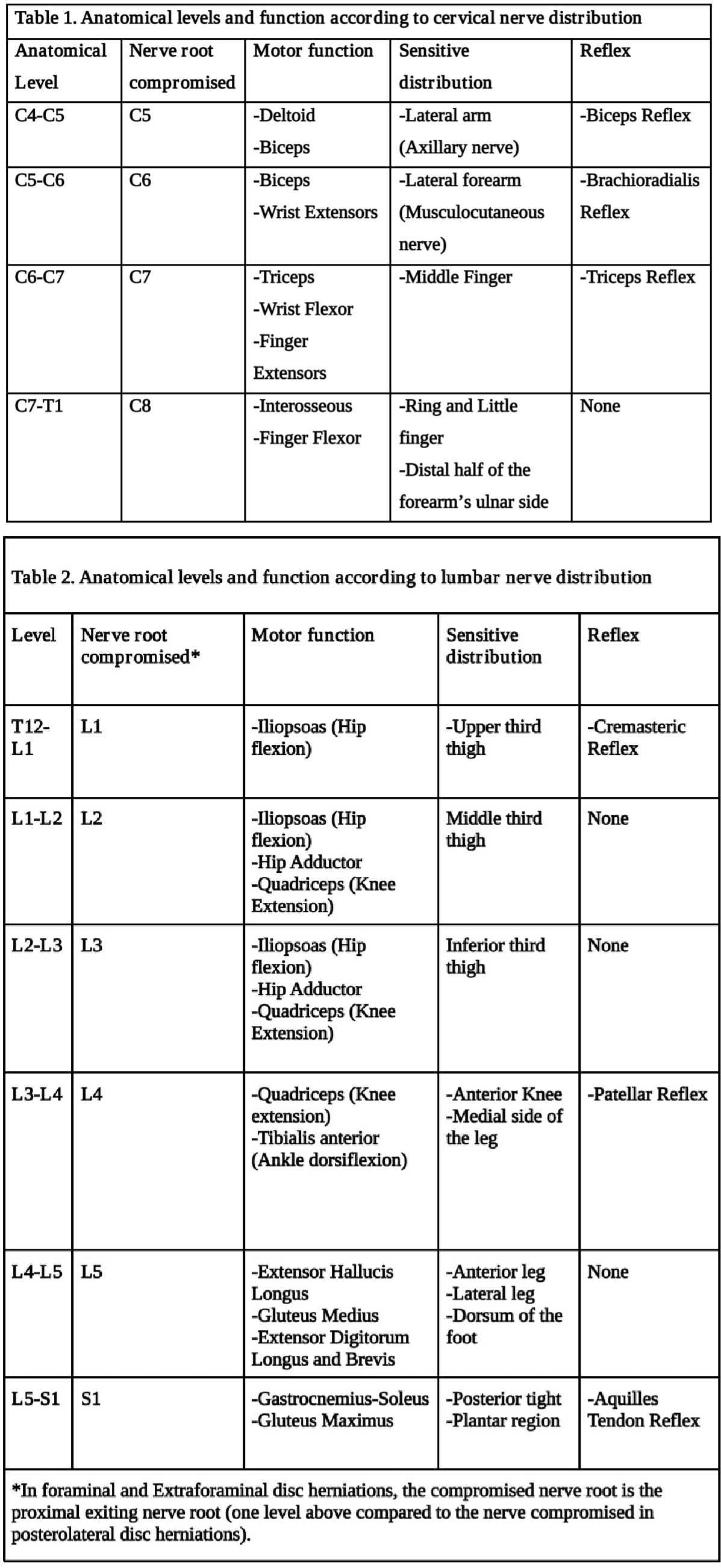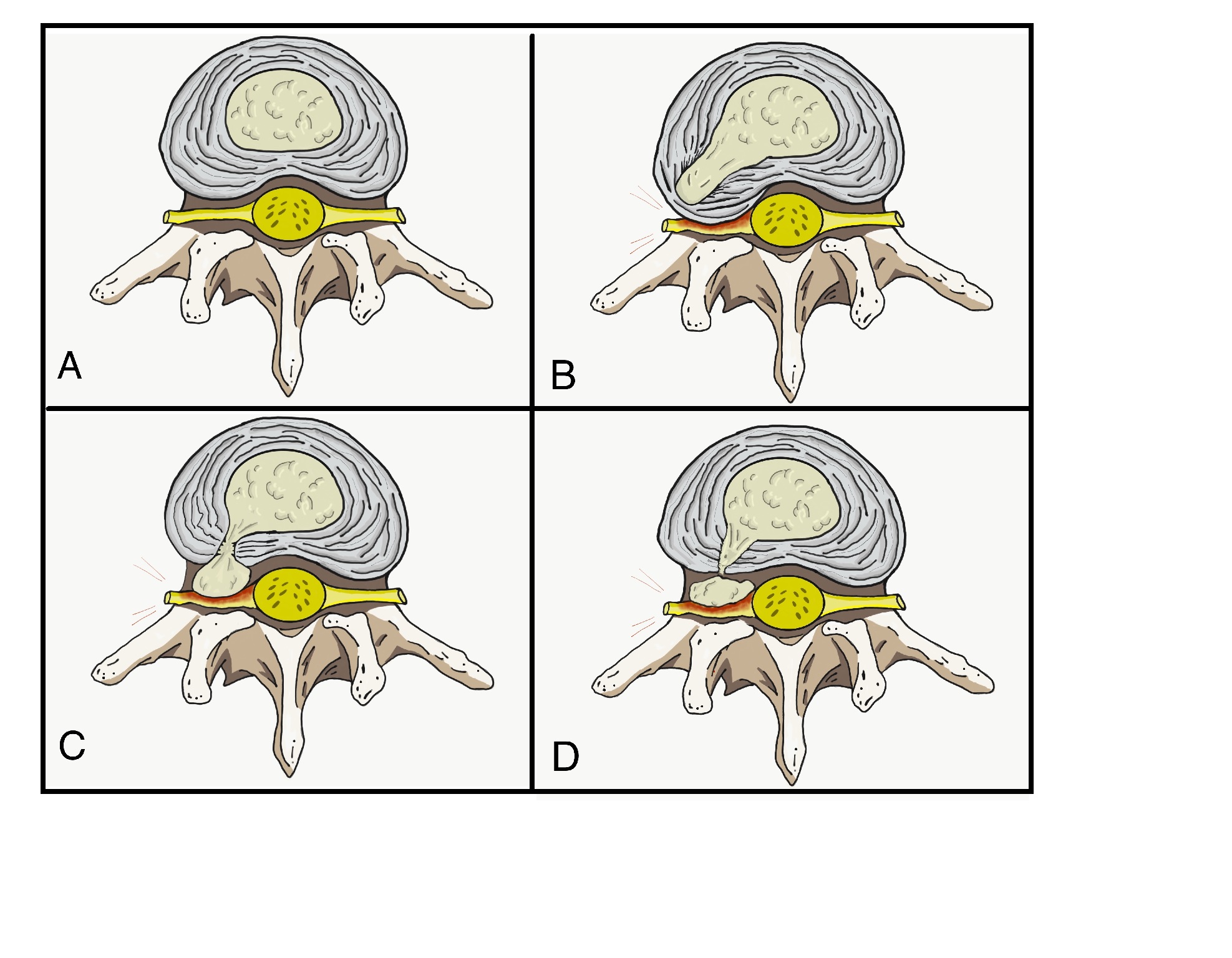[1]
Martin BI, Mirza SK, Comstock BA, Gray DT, Kreuter W, Deyo RA. Reoperation rates following lumbar spine surgery and the influence of spinal fusion procedures. Spine. 2007 Feb 1:32(3):382-7
[PubMed PMID: 17268274]
[2]
Chen S, Fu P, Wu H, Pei M. Meniscus, articular cartilage and nucleus pulposus: a comparative review of cartilage-like tissues in anatomy, development and function. Cell and tissue research. 2017 Oct:370(1):53-70. doi: 10.1007/s00441-017-2613-0. Epub 2017 Apr 17
[PubMed PMID: 28413859]
Level 2 (mid-level) evidence
[3]
He Y, Qiu Y, Zhu F, Zhu Z. Quantitative analysis of types I and II collagen in the disc annulus in adolescent idiopathic scoliosis. Studies in health technology and informatics. 2006:123():123-8
[PubMed PMID: 17108414]
Level 2 (mid-level) evidence
[4]
Roughley PJ, Alini M, Antoniou J. The role of proteoglycans in aging, degeneration and repair of the intervertebral disc. Biochemical Society transactions. 2002 Nov:30(Pt 6):869-74
[PubMed PMID: 12440935]
[5]
Hadjipavlou AG, Tzermiadianos MN, Bogduk N, Zindrick MR. The pathophysiology of disc degeneration: a critical review. The Journal of bone and joint surgery. British volume. 2008 Oct:90(10):1261-70. doi: 10.1302/0301-620X.90B10.20910. Epub
[PubMed PMID: 18827232]
[6]
Battié MC, Videman T, Kaprio J, Gibbons LE, Gill K, Manninen H, Saarela J, Peltonen L. The Twin Spine Study: contributions to a changing view of disc degeneration. The spine journal : official journal of the North American Spine Society. 2009 Jan-Feb:9(1):47-59. doi: 10.1016/j.spinee.2008.11.011. Epub
[PubMed PMID: 19111259]
[7]
MacLean JJ, Lee CR, Alini M, Iatridis JC. The effects of short-term load duration on anabolic and catabolic gene expression in the rat tail intervertebral disc. Journal of orthopaedic research : official publication of the Orthopaedic Research Society. 2005 Sep:23(5):1120-7
[PubMed PMID: 16140193]
[8]
MacLean JJ, Lee CR, Grad S, Ito K, Alini M, Iatridis JC. Effects of immobilization and dynamic compression on intervertebral disc cell gene expression in vivo. Spine. 2003 May 15:28(10):973-81
[PubMed PMID: 12768134]
[9]
Lotz JC, Chin JR. Intervertebral disc cell death is dependent on the magnitude and duration of spinal loading. Spine. 2000 Jun 15:25(12):1477-83
[PubMed PMID: 10851095]
[10]
Lotz JC, Colliou OK, Chin JR, Duncan NA, Liebenberg E. Compression-induced degeneration of the intervertebral disc: an in vivo mouse model and finite-element study. Spine. 1998 Dec 1:23(23):2493-506
[PubMed PMID: 9854748]
[11]
Takahashi K, Miyazaki T, Ohnari H, Takino T, Tomita K. Schmorl's nodes and low-back pain. Analysis of magnetic resonance imaging findings in symptomatic and asymptomatic individuals. European spine journal : official publication of the European Spine Society, the European Spinal Deformity Society, and the European Section of the Cervical Spine Research Society. 1995:4(1):56-9
[PubMed PMID: 7749909]
[12]
Jha SC, Takata Y, Abe M, Yamashita K, Tezuka F, Sakai T, Higashino K, Nagamachi A, Sairyo K. High intensity zone in lumbar spine and its correlation with disc degeneration. The journal of medical investigation : JMI. 2017:64(1.2):39-42. doi: 10.2152/jmi.64.39. Epub
[PubMed PMID: 28373626]
[13]
Siivola SM, Levoska S, Tervonen O, Ilkko E, Vanharanta H, Keinänen-Kiukaanniemi S. MRI changes of cervical spine in asymptomatic and symptomatic young adults. European spine journal : official publication of the European Spine Society, the European Spinal Deformity Society, and the European Section of the Cervical Spine Research Society. 2002 Aug:11(4):358-63
[PubMed PMID: 12193998]
[14]
Uribe JS, Smith WD, Pimenta L, Härtl R, Dakwar E, Modhia UM, Pollock GA, Nagineni V, Smith R, Christian G, Oliveira L, Marchi L, Deviren V. Minimally invasive lateral approach for symptomatic thoracic disc herniation: initial multicenter clinical experience. Journal of neurosurgery. Spine. 2012 Mar:16(3):264-79. doi: 10.3171/2011.10.SPINE11291. Epub 2011 Dec 16
[PubMed PMID: 22176427]
[15]
Chou R, Qaseem A, Snow V, Casey D, Cross JT Jr, Shekelle P, Owens DK, Clinical Efficacy Assessment Subcommittee of the American College of Physicians, American College of Physicians, American Pain Society Low Back Pain Guidelines Panel. Diagnosis and treatment of low back pain: a joint clinical practice guideline from the American College of Physicians and the American Pain Society. Annals of internal medicine. 2007 Oct 2:147(7):478-91
[PubMed PMID: 17909209]
Level 3 (low-level) evidence
[16]
Lateef H, Patel D. What is the role of imaging in acute low back pain? Current reviews in musculoskeletal medicine. 2009 Jun:2(2):69-73. doi: 10.1007/s12178-008-9037-0. Epub 2009 Apr 28
[PubMed PMID: 19468875]
[17]
Sayegh FE, Kenanidis EI, Papavasiliou KA, Potoupnis ME, Kirkos JM, Kapetanos GA. Efficacy of steroid and nonsteroid caudal epidural injections for low back pain and sciatica: a prospective, randomized, double-blind clinical trial. Spine. 2009 Jun 15:34(14):1441-7. doi: 10.1097/BRS.0b013e3181a4804a. Epub
[PubMed PMID: 19525834]
Level 1 (high-level) evidence
[18]
Turk O, Antar V, Yaldiz C. Spontaneous regression of herniated nucleus pulposus: The clinical findings of 76 patients. Medicine. 2019 Feb:98(8):e14667. doi: 10.1097/MD.0000000000014667. Epub
[PubMed PMID: 30813213]
[19]
Gebremariam L, Koes BW, Peul WC, Huisstede BM. Evaluation of treatment effectiveness for the herniated cervical disc: a systematic review. Spine. 2012 Jan 15:37(2):E109-18. doi: 10.1097/BRS.0b013e318221b5af. Epub
[PubMed PMID: 21587105]
Level 1 (high-level) evidence
[20]
Peul WC, van Houwelingen HC, van den Hout WB, Brand R, Eekhof JA, Tans JT, Thomeer RT, Koes BW, Leiden-The Hague Spine Intervention Prognostic Study Group. Surgery versus prolonged conservative treatment for sciatica. The New England journal of medicine. 2007 May 31:356(22):2245-56
[PubMed PMID: 17538084]
[21]
Jacobs WC, van Tulder M, Arts M, Rubinstein SM, van Middelkoop M, Ostelo R, Verhagen A, Koes B, Peul WC. Surgery versus conservative management of sciatica due to a lumbar herniated disc: a systematic review. European spine journal : official publication of the European Spine Society, the European Spinal Deformity Society, and the European Section of the Cervical Spine Research Society. 2011 Apr:20(4):513-22. doi: 10.1007/s00586-010-1603-7. Epub 2010 Oct 15
[PubMed PMID: 20949289]
Level 1 (high-level) evidence
[22]
Lurie JD, Tosteson TD, Tosteson AN, Zhao W, Morgan TS, Abdu WA, Herkowitz H, Weinstein JN. Surgical versus nonoperative treatment for lumbar disc herniation: eight-year results for the spine patient outcomes research trial. Spine. 2014 Jan 1:39(1):3-16. doi: 10.1097/BRS.0000000000000088. Epub
[PubMed PMID: 24153171]
[23]
Benoist M. The natural history of lumbar disc herniation and radiculopathy. Joint bone spine. 2002 Mar:69(2):155-60
[PubMed PMID: 12027305]
[24]
Srikandarajah N, Boissaud-Cooke MA, Clark S, Wilby MJ. Does early surgical decompression in cauda equina syndrome improve bladder outcome? Spine. 2015 Apr 15:40(8):580-3. doi: 10.1097/BRS.0000000000000813. Epub
[PubMed PMID: 25646751]


